Steralization - Study guides, Class notes & Summaries
Looking for the best study guides, study notes and summaries about Steralization? On this page you'll find 29 study documents about Steralization.
Page 3 out of 29 results
Sort by

-
chem210:exam1 study guide, complete verified solution, A+ guarantee, 2024.
- Exam (elaborations) • 6 pages • 2024
-
- $11.99
- + learn more
chem210:exam1 study guide, complete verified solution, A+ guarantee, 2024. properties of organic compounds non-polar; flammable; covalent bonds; insoluble in water; carbon containing molecules; non-conductor in electrolytes; LOW boiling and melting points; gas at room temp. properties of inorganic compounds polar; non-flammable; ionic bonds; soluble in water; conducts electricity; solid at room temp; HIGH boiling/melting points What is the trend in solubility and boiling point/melting...
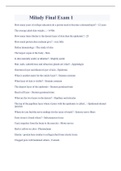
-
Milady Final Exam 1 Latest Updates
- Exam (elaborations) • 11 pages • 2023
-
Available in package deal
-
- $10.49
- + learn more
Milady Final Exam 1 How many years of college education do a person need to become a dermatologist? - 12 years The average adult skin weighs.... - 6-9lbs How many times thicker is the dermis layer of skin than the epidermis? - 25 How much protein does melanin give? - very little Define dermatology - The study of skin The largest organ of the body - Skin Is skin naturally acidic or alkaline? - Slightly acidic Hair, nails, sudoriferous and sebaceous glands are what? - Appen...
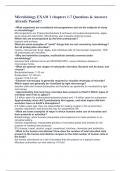
-
Microbiology EXAM 1 chapters 1-7 Questions & Answers Already Passed!!
- Exam (elaborations) • 20 pages • 2024
-
Available in package deal
-
- $15.50
- + learn more
Microbiology EXAM 1 chapters 1-7 Questions & Answers Already Passed!! • What organisms are considered microorganisms and are the subjects of study in microbiology? Microorganisms are Prokaryotes(bacteria & archaea) and eukaryotes(protozoa, algae, some fungi and helminths). Microbiology also includes studying viruses . Which two are encompassed by the term prokaryotes? bacteria and archaea What are some examples of "small" things that are not covered by microbiology? Are all prokaryote...
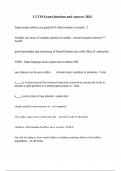
-
CLTM Exam Questions and Answers 2024
- Exam (elaborations) • 90 pages • 2024
-
Available in package deal
-
- $13.00
- + learn more
Deep tendon reflexes are graded 0-4 which number is normal - 2 Number one cause of complex partial sz in adults - mesial temporal sclerosis ** boards gum hypertrophy and coarsening of foacial features are a side effect of - phenytoin FMRI - Maps language motor spikes and evaluates CBF eeg changes can be seen within of acute injury resulting in ischemia - 5 min a sz is characterized by sustained muscular contraction causing the body to assume a rigid position or a stereotyped posture is - to...

-
Analyze and Implications of Self-concept, Stereotypes, and Generalizations
- Class notes • 5 pages • 2023
-
- $10.89
- + learn more
This document shows crucial components of workplace cultural intelligence. The clash between Julia and Joanne's management styles exemplifies the necessity of acknowledging and valuing individual variations. The conflict highlights the importance of excellent communication and flexible conflict resolution tactics. It also highlights the impact of business culture on employee engagement and morale, as Julia's sentiments of restriction and underutilization prompt her to seek other work opportuni...
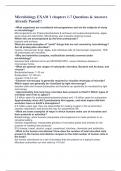
-
Microbiology EXAM 1 chapters 1-7 Questions & Answers Already Passed!!
- Exam (elaborations) • 20 pages • 2024
-
- $16.49
- + learn more
Microbiology EXAM 1 chapters 1-7 Questions & Answers Already Passed!! • What organisms are considered microorganisms and are the subjects of study in microbiology? Microorganisms are Prokaryotes(bacteria & archaea) and eukaryotes(protozoa, algae, some fungi and helminths). Microbiology also includes studying viruses . Which two are encompassed by the term prokaryotes? bacteria and archaea What are some examples of "small" things that are not covered by microbiology? Are all prokaryote...

-
Mark Klimek Lecture Outline Exam Questions And Answers
- Exam (elaborations) • 59 pages • 2024
-
- $10.99
- + learn more
Mark Klimek Lecture Outlines If the pH and the BiCarb are both in the same direction then it is? - ANS Metabolic If the pH is up it is? - ANS Alkalosis If the pH is down it is? - ANS Acidosis As the pH goes so goes my patient except for? - ANS Potassium If the pH is up my patient with show signs and symptoms of? - ANS Increase... like tachycardia,diarrhea and borborygmi If the pH is down my pati...
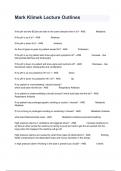
-
Mark Klimek Lecture Outlines
- Exam (elaborations) • 59 pages • 2024
-
- $11.89
- + learn more
Mark Klimek Lecture Outlines If the pH and the BiCarb are both in the same direction then it is? - ANS Metabolic If the pH is up it is? - ANS Alkalosis If the pH is down it is? - ANS Acidosis As the pH goes so goes my patient except for? - ANS Potassium If the pH is up my patient with show signs and symptoms of? - ANS Increase... like tachycardia,diarrhea and borborygmi If the pH is down my pati...
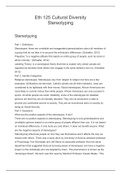
-
Eth 125 Cultural Diversity Stereotyping Stereotyping Part 1: Definitions Stereotypes; these are unreliable and exaggerated generalizations about all members of a group that do not take in to account the individual's differences. (Schaef
- Summary • 3 pages • 2021
-
- $3.49
- + learn more
Eth 125 Cultural Diversity Stereotyping Stereotyping Part 1: Definitions Stereotypes; these are unreliable and exaggerated generalizations about all members of a group that do not take in to account the individual's differences. (Schaefer, 2012) Prejudice; ' is a negative attitude that rejects an entire group of people, such as racial or ethnic minority.' (Schaefer, 2012) Labeling Theory; is a sociological theory that tries to explain why certain people are regarded as d...

How much did you already spend on Stuvia? Imagine there are plenty more of you out there paying for study notes, but this time YOU are the seller. Ka-ching! Discover all about earning on Stuvia


